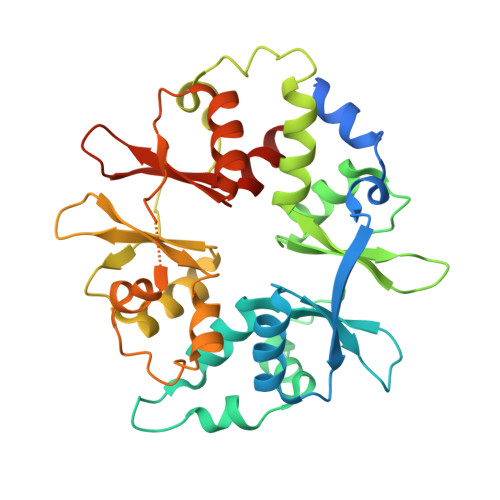Selective Activation of AMPK beta 1-Containing Isoforms Improves Kidney Function in a Rat Model of Diabetic Nephropathy.
Salatto, C.T., Miller, R.A., Cameron, K.O., Cokorinos, E., Reyes, A., Ward, J., Calabrese, M.F., Kurumbail, R.G., Rajamohan, F., Kalgutkar, A.S., Tess, D.A., Shavnya, A., Genung, N.E., Edmonds, D.J., Jatkar, A., Maciejewski, B.S., Amaro, M., Gandhok, H., Monetti, M., Cialdea, K., Bollinger, E., Kreeger, J.M., Coskran, T.M., Opsahl, A.C., Boucher, G.G., Birnbaum, M.J., DaSilva-Jardine, P., Rolph, T.(2017) J Pharmacol Exp Ther 361: 303-311
- PubMed: 28289077
- DOI: https://doi.org/10.1124/jpet.116.237925
- Primary Citation of Related Structures:
5T5T - PubMed Abstract:
Diabetic nephropathy remains an area of high unmet medical need, with current therapies that slow down, but do not prevent, the progression of disease. A reduced phosphorylation state of adenosine monophosphate-activated protein kinase (AMPK) has been correlated with diminished kidney function in both humans and animal models of renal disease. Here, we describe the identification of novel, potent, small molecule activators of AMPK that selectively activate AMPK heterotrimers containing the β 1 subunit. After confirming that human and rodent kidney predominately express AMPK β 1, we explore the effects of pharmacological activation of AMPK in the ZSF1 rat model of diabetic nephropathy. Chronic administration of these direct activators elevates the phosphorylation of AMPK in the kidney, without impacting blood glucose levels, and reduces the progression of proteinuria to a greater degree than the current standard of care, angiotensin-converting enzyme inhibitor ramipril. Further analyses of urine biomarkers and kidney tissue gene expression reveal AMPK activation leads to the modulation of multiple pathways implicated in kidney injury, including cellular hypertrophy, fibrosis, and oxidative stress. These results support the need for further investigation into the potential beneficial effects of AMPK activation in kidney disease.
Organizational Affiliation:
CVMET Research Unit (C.T.S., R.A.M., E.C., A.R., J.W., A.J., B.S.M., M.A., H.G., M.M., K.C., E.B., M.J.B., P.D.-J., T.R.), Worldwide Medicinal Chemistry (K.O.C., D.J.E.), and Pharmacokinetics, Dynamics, & Metabolism (A.S.K., D.A.T.), Pfizer Worldwide Research and Development, Cambridge, Massachusetts; and Worldwide Medicinal Chemistry (M.C., R.K., F.R., A.S., N.E.G.), and Drug Safety Research and Development (J.M.K., T.M.C., A.C.O., G.G.B.), Pfizer Worldwide Research and Development, Groton, Connecticut christopher.t.salatto@pfizer.com.




























